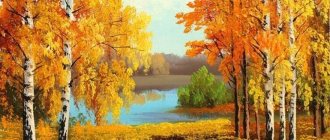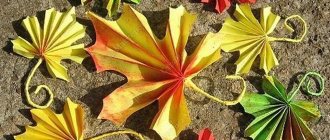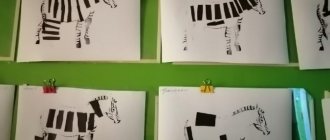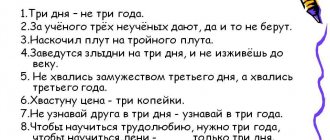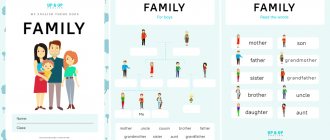MAGAZINE Preschooler.RF
Project “Trees in Autumn” in the senior group of compensatory orientation for children with mental retardationProject type: educational-research creative
Project type: group
Project duration: short-term (2 weeks)
Participants: children of the senior correctional group, a speech pathologist, a speech therapist, a teacher, a music director, and parents.
Relevance of the project:
Autumn is a favorable time of year to observe and change trees.
Children's participation in the project will allow:
- enrich knowledge and ideas about the life of trees in autumn
- give an idea that most tree leaves change color in autumn
- introduce such a wonderful autumn phenomenon as leaf fall
- remember the names of trees, their structure and purpose
- learn to take care of trees.
Expected Result:
To form in children a system of knowledge about changes in the life of trees in autumn.
Create conditions for children to develop a holistic understanding of the life of trees in autumn.
To instill in children a caring attitude towards trees.
Objective of the project:
Expanding and enriching children's knowledge about the changes that occur in the life of trees in the fall.
Project objectives:
Educational:
- expand children's knowledge about the changes that occur in nature with the arrival of autumn
- enrich knowledge about autumn natural phenomena and the life of trees in autumn
- teach to recognize and distinguish trees in the immediate environment by external signs
- Give children the opportunity to learn what determines the color of autumn leaves and how plants prepare for winter.
Correctional and developmental:
- develop visual attention and perception, memory
- develop speech and phonemic hearing
- develop observation skills and the ability to draw independent conclusions
- enrich and activate children's vocabulary
- develop lexical and grammatical skills, practice the formation of relative adjectives, coordinating them in gender, number and case
- develop coherent speech
- develop gross and fine motor skills.
Correctional and educational:
- cultivate a love for the nature of your native land
- develop independence skills
- cultivate a desire to work in a team.
Stages of work on the project
Stage I – preparatory.
Drawing up a plan for joint work with children, parents, conversations, development of OD notes, selection of artistic, demonstration, handouts and equipment for OD, didactic games with children, development of holiday leisure scenarios.
Stage II – practical. Project implementation.
Excursion around the territory of the kindergarten.
Observing trees and shrubs on walks and changes in nature in autumn.
Contents of practical activities to implement the project
for all sections of the program:
1. Cognitive development
- Getting to know the world around you:
- viewing reproductions of paintings by artists on the topic
Observation cycle:
- for changes in autumn nature during walks
- for the beauty and richness of autumn colors
- behind the trees growing on the territory of the kindergarten
- Situational conversations:
“Why do we like autumn?” , “Why can’t you break branches?” , “How to help a wounded tree?”
- Didactic games: “Which tree is the leaf from?” , “Which branch are the kids from?” , “Find out by description” , “Good - bad” , “The fourth odd” , “What is missing” .
- OOD for FCCM (teacher-defectologist) “Walk in the autumn forest”
- Formation of elementary mathematical concepts
OOD (teacher-defectologist) “Let’s help the baby squirrel learn to count”
OOD (teacher-defectologist) “How the owlet compared trees”
- Games and exercises for FEMP: “Find and show” , “Lay out correctly” , “Make it equally” , “Continue the row” , “Thicker - thinner” .
- Target walks:
“Trees and shrubs of our kindergarten”,
“Looking for signs of autumn”.
2. Speech development
- Looking at illustrations about autumn.
- Memorizing poems and riddles about trees and autumn.
- Work on retelling the text.
- Conversations: “Signs of autumn” , “Why trees shed their leaves” ,
- OOD on the formation of lexical and grammatical categories (teacher-speech therapist):
"What Happens to Trees in Autumn".
- OOD on the development of coherent speech (teacher-speech therapist): Retelling the story “Tree Argument” according to K.D. Ushinsky
- Word games: “Name it affectionately” , “One-many” , “Which sheet” , “Match the action to the object” , “Say the opposite” , “Count to five” .
- Reading fiction:
M. Prishvin “Fall of Leaves” , E. Moshkovskaya “Grandfather – Tree” ,
S. Kozlov “Such a Tree” , E. Serova “Green Country” , A. Lopatina “The Wisdom of a Tree” , A. Lopatina “The Life of a Tree” , “Lipka’s Gifts” , S. Prokofieva “The Tale of a Little Oak Tree” , E. Trutneva “Autumn” , N. Sladkov “Autumn on the threshold” , O. Belyavskaya “Leaf fall” ,
A.S. Pushkin “The sky was already breathing in autumn...” , A.S. Pushkin “Sad time!
The charm of the eyes!
3. Social and communicative development
- Role-playing games: “Seed Store” , “Family. Plot – We are going for a walk in the park .
- Didactic games: “Seasons” , “Find out by description” , “Guess the riddle - draw the answer!” , “Which branch are the kids from?” , “Find the tree by description .
- Board and printed games: “Seasons” , “Trees of our land” ,
"Collect a picture".
- Labor activity: collecting natural material while walking, cleaning up fallen leaves.
4. Artistic and aesthetic development
- Organized educational activities:
Drawing “The beauty of nature in autumn” , “Trees in autumn”
Modeling “Such different leaves” (using the “plasticineography” )
Applique “Fox from maple leaves”
Application Collective work “Birch tree in autumn”
Drawing “Our site in autumn” , “Leaf fall”
- Independent artistic activity:
- Listening to music:
P. I. Tchaikovsky “Autumn Song” , “Seasons” , A. Vivaldi “Autumn” .
5. Physical development
- Outdoor games: “One, two, three - run to the tree!” , “Autumn leaves” , “I know 5 names” (trees).
- Physical education lessons: “Leaves in autumn” , “The wind blows in our faces” ,
"Autumn leaves are quietly spinning".
- Development of fine motor skills: Finger gymnastics “Trees” , “What leaves look like” .
- Games: “Arrange the leaves by color” , “Arrange the leaves from small objects” , “Decorate the leaves” .
Stage III is the final stage.
Working with parents: exhibition of crafts “Autumn Fantasies” .
Festive leisure “Let's help the Sun return the colors of autumn”
Presentation of the project “Trees in Autumn” .
Result: The project allowed children to expand their knowledge about the nature of their native land and the benefits of trees. The children received answers to their questions and drew conclusions:
- All people need to take care of trees
- know the structure of a tree: root, trunk, branches, leaves
- love your land, your nature.
At the end of the project, the level of children's knowledge about trees increased. The project contributed to the expansion and deepening of children's ideas about the nature of their native land of the Moscow region.
Literature:
- Nikolaeva S. N. “Young ecologist” , “Mosaic-Synthesis” , 2021.
- Ushakova O.S., Strunina E.M. “Development of speech and creativity of preschool children” , “TC Sfera” , 2021.
- Maslennikov O.M., Filippenko A.A. Environmental projects in kindergarten, Volgograd: Teacher, 2016
- I.A. Pomoraeva, V.A. Pozina Formation of elementary mathematical concepts: Senior group. – M.: “Mosaic-Synthesis” , 2021.
- Koldina D.N., Modeling with children 5-6 years old, “Mosaic-Synthesis” , 2021.
- Koldina D.N., Drawing with children 5-6 years old, “Mosaic-Synthesis” , 2021.
- Bukharina K.E. Lesson notes on the development of lexical and grammatical concepts and coherent speech in children 5-6 years old with ODD and mental retardation: a methodological manual - M.: Humanitar. ed. VLADOS center, 2021.
- Bardysheva T.Yu., Monosova E.N. Speech therapy classes in kindergarten. Senior group. -M.: Publishing house "Scriptorium 2003" , 2010.
- Reader for children of senior preschool age. Ed. IN AND. Loginova. –M.: Enlightenment.
- http: //vospitatel. com. ua/ website Educator (class notes at preschool educational institutions)
Sedova Lyudmila Vasilievna
Teacher-speech pathologist/Teacher-speech therapist
Kondratieva Evgenia Evgenievna
Teacher of preschool educational institution No. 25 “Smile”
G.o. Podolsk, Moscow region
| Next > |
Lesson summary for the preparatory group “Trees in Autumn”
Svetlana Agafonova
Lesson summary for the preparatory group “Trees in Autumn”
Lesson notes
on the surrounding world in the preparatory group on the topic :
«Trees in autumn»
Goals:
-Enrich and clarify vocabulary on the topic: signs of autumn ; fixing the names of trees by leaves , seeds and fruits of trees ; development of general and fine motor skills
- cultivate a love for nature.
Demo material:
Pictures (oak, rowan, birch, aspen, maple, pine, spruce)
;
autumn bouquet ; leaves of trees (birch, linden, maple, oak, pine, spruce)
; seeds and fruits
of trees ; paper, pencil.
1. Organizational moment
Game "Repeat"
Oak-rowan-pine, birch-spruce-maple, maple-rowan-fir, birch-oak-rowan, spruce-oak-maple, maple-rowan-fir, birch-oak-rowan, spruce-oak-pine, oak- maple-birch.
Q: What do you think autumn ?
(I put an autumn bouquet )
B: -Let's smell it
(children lean towards the bouquet and take a deep breath through their noses without raising their shoulders).
D: -Autumn smells of fallen leaves, the last flowers, dampness and coolness.
Game “Name the signs of autumn ”
-The sun is shining, but it does not warm. The days are getting shorter and the nights are getting longer. on trees and shrubs turn yellow and fall off. The grass withers and withers. Insects are hiding. Birds fly away to warmer regions. It rains often. It's getting chilly.
2. Conversation about trees
Q: -Let’s remember what kind of trees there are ?
(show pictures of deciduous and coniferous trees )
.
D: -Trees are deciduous and coniferous.
Q: -Which trees are deciduous?
D: - Birch, linden, oak, maple.
Q: - What trees are coniferous ?
D: - Spruce, pine
Q: -If both deciduous and coniferous trees grow in the forest, this is...
D:-Mixed forest
Q: -If only coniferous trees are... .
D:-Coniferous forest
Q: -If only birches, oaks, lindens, and aspens grow in the forest, this is ....
D:-deciduous forest
Q: - Which of these trees shed their leaves in the fall ?
D:-deciduous trees
Q: Why do the leaves on trees turn yellow and fall off in the fall?
D: - There is little light and warmth.
Q: - How do trees ? What protects them from the cold? Turns out
in winter all the trees sleep . They stop eating and growing. They are protected from the cold by cork fabric under the bark, which prevents the tree from freezing . Fallen leaves on the ground warm the roots of the trees .
3. Physical exercise “We will become trees ”
.
We will become trees (Children place their feet shoulder-width apart, hands on their belts.)
Strong big
Feet are roots
Let's spread them wider, (Spread their legs wider.)
To hold the tree , (A clenched fist is placed over another fist.)
They didn't let me fall
From the distant depths (Bend over, cup their palms, unbend.)
They got water.
Our body is a mighty trunk
He sways a little (Sway from side to side.)
And with its sharp tip (We fold our palms into a hut, with the sharp end up.)
It rests against the sky (Raise our joined hands up.)
Our hands are branches, (Open palms in raised arms.)
They form a crown together (Close fingers above head.)
In the crown they are not at all afraid, (Shakes their heads)
When the winds blow strongly (Swing with raised arms.)
The fingers will be like twigs, (Move the fingers of both hands.)
The leaves cover them (Cover one palm with the other.)
As autumn , (Raise up their right, then left hands.)
The leaves will fly away in an instant (Spread your arms to the sides)
.
4. Game “ Trees , leaves and fruits”
(Children name a tree , pick up a leaf and fruits for it.)
5. Exercise “Recognize a tree by its bark ”
(illustrations of trees . Children use the illustration to find the bark of a given tree )
Q: -We determined which tree the leaf came , named the tree , and now try to recognize the tree by its bark .
(children look at the bark of trees and determine which tree it )
6. Didactic game “Find a tree by seeds and fruits ”
(children guess the tree )
7. Outlining and shading of leaves
Q: - What tree is the leaf ?
D: - from maple
Q: -Attach it to a piece of paper, trace it along the outline, and then shade it with horizontal lines in red, yellow and orange colors so that they appear golden.
8. Summing up the lesson .
List of used literature:
1. KRO. Familiarization with the surrounding world. Lesson notes for 6-7 years old .
2. I. V. Durova Speech development Thematic dictionary in pictures. The world of plants and mushrooms.
3. https://ekosky.narod.ru/index/0-2
4.https://www.karakyli.ru/2014/10/02/derevya-listya-igra/

